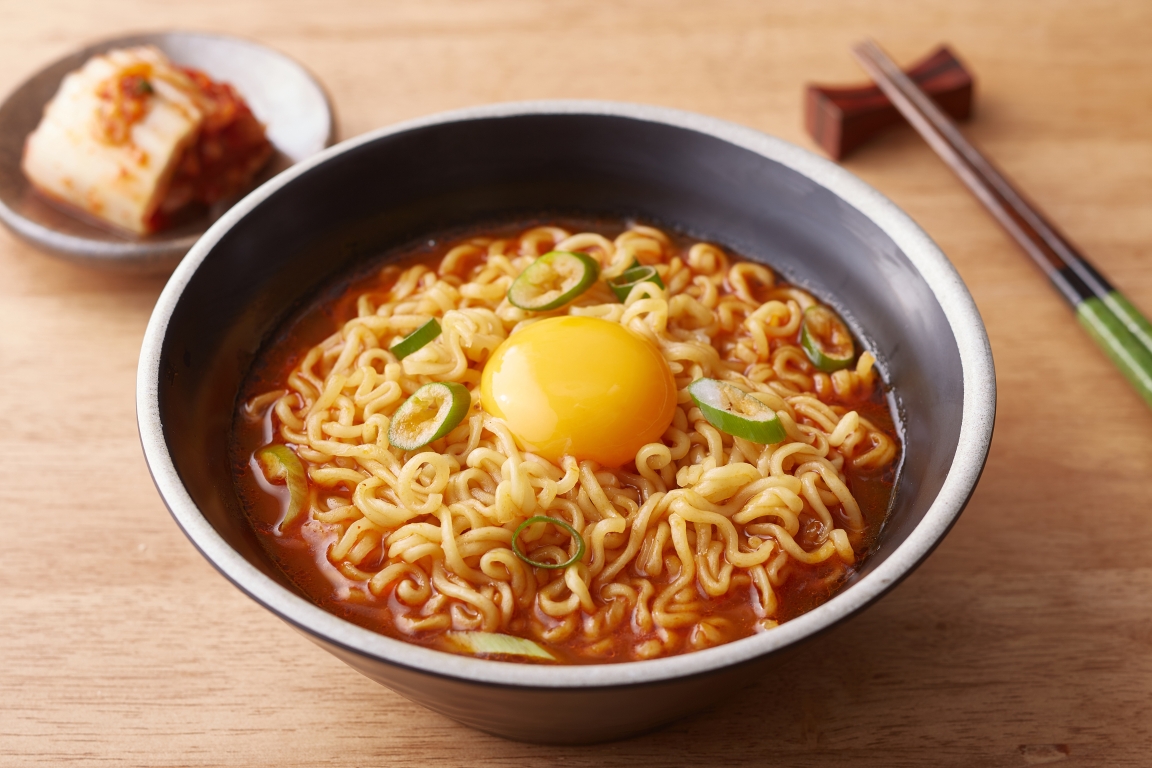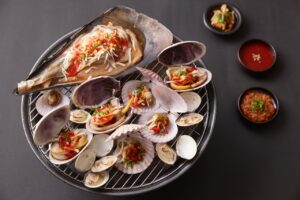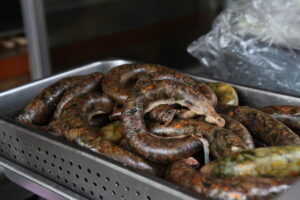
Ramyeon ⓒ한국관광공사 사진갤러리-디그램
Do you like Korean Ramyeon?
The Easy Korean World of Ramen to Enjoy at Home
If you like Korea, you might have heard about ramen once.
Ramen, which can be easily enjoyed by Koreans who like soup dishes, is another pleasure in eating.
Food manufacturers such as Nongshim, Samyang, Ottogi, and Faldo are launching ramen noodles.
Today, I would like to introduce the history of ramen and the kinds of ramen by manufacturer.
History
The history of ramyeon in Korea is an interesting journey that reflects the country’s culinary evolution. Ramyeon, often spelled as “Ramyeon” or “Ramen,” refers to instant noodles in Korea. Here’s a brief overview of the history of ramyeon in Korea:
- Introduction of Noodles:
- Noodles have been a part of Korean cuisine for centuries. Traditional Korean noodle dishes like “janchi-guksu” (feast noodles) and “naengmyeon” (cold noodles) have existed for a long time, but they differ significantly from modern instant ramyeon.
- Japanese Influence:
- The concept of instant noodles is largely credited to Japan. In 1958, Momofuku Ando introduced the world’s first instant noodles, which he called “Chikin Ramen.” This innovation soon led to the creation of instant ramyeon.
- Arrival in Korea:
- Instant noodles made their way to South Korea in the early 1960s, primarily through the import of Japanese products like “Nissin Ramen.” These early versions of instant noodles were foreign to Koreans but gained popularity due to their convenience and affordability.
- Korean Adaptation:
- As the popularity of instant noodles grew in Korea, local companies started developing their own brands and flavors to cater to the Korean palate. One of the first Korean instant ramyeon brands was “Samyang Ramyeon,” introduced in 1963.
- Advancements and Diversification:
- Over the years, Korean ramyeon manufacturers made significant advancements, creating a wide variety of flavors, from mild to spicy. Brands like Shin Ramyeon, developed by Nongshim, became immensely popular and are now renowned worldwide.
- Cultural Significance:
- Ramyeon has not only become a quick and convenient meal but also holds cultural significance in Korea. It is often associated with comfort food and late-night dining, especially in combination with other ingredients like kimchi, eggs, and vegetables.
- Export and Global Popularity:
- Korean ramyeon has achieved international acclaim, with brands exporting their products to various countries. Korean instant noodles are appreciated for their unique and bold flavors.
- Instant Jjapaguri from the Movie “Parasite”:
- The Korean film “Parasite,” directed by Bong Joon-ho, featured a dish called “Jjapaguri,” a combination of two popular Korean instant noodles, Jjapagetti and Neoguri. This gained worldwide attention and further increased the popularity of Korean ramyeon.
In summary, the history of ramyeon in Korea began with the introduction of instant noodles from Japan in the 1960s. Over time, it evolved into a distinct and beloved part of Korean cuisine, with a wide range of flavors and cultural significance. Korean ramyeon has not only become a quick and convenient meal option but also a symbol of comfort and nostalgia for many Koreans and food enthusiasts around the world.
Top5 Rank
- Shin Ramyun (신라면) by Nongshim:
- Shin Ramyun is one of the most iconic and beloved ramyeon brands in Korea. Known for its spicy flavor and rich broth, it’s a favorite among those who enjoy a little heat in their noodles.
- Samyang Ramyeon (삼양라면) by Samyang Food:
- Samyang Ramyeon was one of the earliest Korean instant noodle brands and is still popular for its mild and comforting flavors. It comes in various types, including Spicy Chicken Ramyeon (Buldak Ramyeon), which is famous for its fiery spiciness.
- Neoguri (너구리) by Nongshim:
- Neoguri is known for its seafood flavor and chewy udon-like noodles. It’s particularly favored by those who enjoy a slightly different ramyeon experience compared to traditional flavors.
- Jjapaguri (짜파구리):
- Jjapaguri, also known as “Jjapaguri,” gained worldwide attention after its appearance in the film “Parasite.” It’s a combination of Jjapagetti (black bean sauce noodles) and Neoguri (spicy seafood noodles). This unique fusion of flavors became an instant hit.
- Paldo Bibimmyeon (팔도 비빔면):
- Bibimmyeon is a type of cold, spicy ramyeon that is popular in Korea, especially during hot summer months. Paldo’s Bibimmyeon is well-regarded for its spicy and tangy sauce, making it a refreshing and zesty choice.
Fire Noodle
Buldak Bokkeum-myeon, also known as “Fire Noodles,” is a popular and extremely spicy instant ramyeon in South Korea. Here’s some information about Buldak Bokkeum-myeon:
1. Spiciness: Buldak Bokkeum-myeon is famous for its intense spiciness. It’s often regarded as one of the spiciest instant noodles available in the market. The “Buldak” in its name translates to “fire chicken,” emphasizing its fiery nature.
2. Flavor: Despite its extreme heat, Buldak Bokkeum-myeon has a savory and slightly sweet flavor, which helps balance the intense spiciness. It typically includes a sauce or seasoning packet that you mix with the cooked noodles.
3. Popularity: This ramyeon gained popularity not only in Korea but also internationally. Many people enjoy the thrill of taking on the “fire noodle challenge” to test their tolerance for spicy food.
4. Varieties: Over the years, the Buldak Bokkeum-myeon brand has expanded to include various versions with different spice levels and flavor variations. Some are even designed to be even spicier, offering different levels of heat for adventurous eaters.
5. Cooking: To prepare Buldak Bokkeum-myeon, you typically boil the noodles, drain them, and then mix them with the provided sauce or seasoning. It’s common to add toppings like vegetables, cheese, or a fried egg to enhance the flavor.
6. Online Challenges: The extreme spiciness of Buldak Bokkeum-myeon has led to the creation of online challenges and viral videos of people attempting to finish a whole serving. Some even time themselves to see how quickly they can eat the noodles without taking a drink.
Please note that Buldak Bokkeum-myeon is not for everyone due to its intense spiciness. If you enjoy spicy food, it can be a fun and flavorful option to try, but be prepared for a serious kick of heat. There are milder versions available for those who prefer a less fiery experience.

Cooking Method
Shin Ramyeon, a popular brand of Korean instant noodles known for its spicy flavor, is easy to prepare. Here’s a simple cooking method for making it.
Ingredients:
- 1 packet of Shin Ramyeon noodles
- 2 cups of water
- Optional toppings (e.g., sliced green onions, vegetables, tofu, egg)
Instructions:
- Boil Water:
- Start by boiling 2 cups of water in a pot. Make sure the pot is large enough to accommodate the noodles and allow them to cook evenly.
- Add Noodles:
- Once the water is boiling, open the Shin Ramyun packet and add the noodles to the pot.
- Cook Noodles:
- Allow the noodles to cook in the boiling water for about 4-5 minutes, or as per the instructions on the packaging. Stir occasionally to prevent sticking and ensure even cooking.
- Add Seasoning:
- While the noodles are cooking, the Shin Ramyun packet typically contains a separate seasoning packet. You can add this seasoning to the pot during the last minute of cooking. This helps to infuse the soup with the spicy flavor.
- Customize with Toppings (Optional):
- You can enhance your Shin Ramyun by adding various toppings according to your preference. Common choices include sliced green onions, bok choy, mushrooms, tofu, or a cracked egg. These can be added to the pot a minute or two before the noodles are ready.
- Serve:
- Once the noodles are cooked to your desired level of doneness and the seasoning is mixed in, remove the pot from the heat.
- Enjoy:
- Transfer the cooked Shin Ramyun and its contents into a bowl and enjoy your spicy and flavorful Korean ramyeon.
Keep in mind that the cooking time and the amount of water used may vary slightly depending on your personal preferences. Some people like their noodles with more or less broth, so feel free to adjust the water quantity accordingly. Additionally, you can customize your Shin Ramyun by adding or omitting ingredients to suit your taste. Enjoy your delicious and spicy bowl of Shin Ramyeon!
…
…
…





